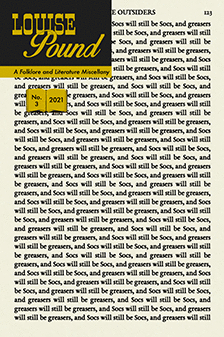Browse Journals and Peer-Reviewed Series
International Dialogue (The Goldstein Center for Human Rights)
ISSN 2155-160X
International Dialogue (ID) is a multidisciplinary peer-reviewed academic e-journal aimed at scholars, policy makers, and practitioners who seek an interactive forum for the cross-fertilization of ideas and perspectives about world affairs.
Journal of Curriculum, Teaching, Learning and Leadership in Education
Editors-in-Chief
- Elliott Ostler, University of Nebraska at Omaha
- Shari DeVeney, University of Nebraska at Omaha
- Julie Bell, University of Nebraska at Omaha
Special Issue Call for Proposals.
- Special Issue on Literacy in Education. Call for submissions for Fall 2025:
- · Reading instruction and/or interventions
- · Writing instruction and/or interventions
- · Literacy skill development
- · Literacy practices in PK-12 and higher education
- · Education professional preparation with respect to reading and writing subject knowledge
- · Dyslexia
- · Literacy curriculum development
- · Literacy as it related to science, technology, engineering, arts, and mathematics (STEAM)
- · Socio-cultural influences on reading and writing instruction, development, and/or intervention
- · Multilingual or multicultural perspectives on reading and/or writing instruction
- · Contemporary education issues regarding reading and writing across the lifespan
- Inter-disciplinary and inter-professional scholarly works are encouraged.
- Manuscripts consider for publication include, but are not limited to, the following:
- · Innovative instructional ideas
- · Research findings
- · Essays on educational topics
- · Editorials on contemporary education issues
- · Descriptions of innovative curriculum and teaching materials
- · Descriptions of innovations and inventions
- · Reviews of education-related materials, books, and websites
- Submission Procedures:
- Manuscripts should be 5,000 to 8,000 words (references included), in Times New Roman, 12-point font, double-spaced, in APA Seventh Edition format. All submissions will be peer reviewed. Manuscripts must be submitted via the journal's website. Submission deadline: April 15, 2025.
- As always, the CTTLE journal continues to accept manuscripts from a wide range of educational and education-related topics regardless of eligibility for special issue status.
- The Special Issue Will:
- * Highlight the research and best practices that literacy educators or education professionals are doing in their own contexts.
- * Connect to current trends in education (e.g., learning loss, social-emotional learning, mental health, education professional retention / shortage, increased student needs, instructional practices, intervention practices, assessment).
- * Offer ideas or solutions that are practical and applicable across contexts.
- For the purposes of this special issue, manuscripts submitted for publication should consider addressing the following items:
- * A strong Literature framework: current literature (majority within the last 5 years),
- * Provide practical, applicable recommendations for eductors (if submitting a "Best Practices" manuscript)
- * Address diverse learner populations and contexts
- * Challenge dominant or traditional forms of thinking with possible innovations or uniquely practical findings/solutions
- Submission Deadline: April 15, 2025
- CTLLE Editor: Dr. Julie Bell, Dr. Shari DeVeney, Dr. Elliott Ostler
- The Journal of Curriculum, Teaching, Learning, and Leadership in Education (CTTLE) is a peer-reviewed, open-access journal with no author fees maintained through the University of Nebraska at Omaha College of Education, Health, and Human Sciences. The journal was developed in 2016, and since that time, has published 7 volumes, 9 issues (including 3 special-topic issues), and over 65 articles on a wide range of educational and education-related topics from authors across the United States and the world. The readership distribution is far-reaching as CTLLE articles have been downloaded in over 175 different countries by colleagues at over 3,000 distinctive institutions. As always, CTLLE continues to accept manuscripts from a wide range of education professionals and education-related topics regardless of eligibility for special issue status. There is no deadline for standard submissions.
For more information or to submit a proposal visit Call for Proposals.
Journal of Religion & Film
ISSN 1092-1311
Louise Pound: A Folklore and Literature Miscellany
This is the digital home of Louise Pound: A Folklore and Literature Miscellany, an occasional publication that showcases creative scholarly work in folklore and/or literature.

Selected Proceedings - Hispanic Linguistics Symposium 2024
The Selected Proceedings of the Hispanic Linguistics Symposium 2024 is a peer-reviewed open-access publication that features innovative research on Hispanic and Portuguese linguistics. Its primary aim is to showcase some of the studies that were presented at the Hispanic Linguistics Symposium held in Omaha in October 2024. These investigations contribute to a deeper understanding of current issues in Hispanic and Portuguese linguistics, covering diverse areas such as phonology, syntax, semantics, sociolinguistics, language acquisition, and psycholinguistics.
By publishing on the Digital Commons platform, the proceedings seek to enhance the visibility, accessibility, and impact of the research presented at the symposium.
Space and Defense
ISSN 2380-131X
See the Aims and Scope for a complete coverage of the journal.
Call for Papers
Special Issue: Exploring Artic Security and Defense
Submission dealine is January 12, 2024
See the Call for Papers for more information.
See the Policies and Submission Guidelines for information of submission guidelines and polices.
